Just think, how many times have you seen people making banana peel fertilizer for their plants, on the web? I think, hundreds of huh! But, can banana peel fertilizer for indoor plants actually work?
Banana peel fertilizer for indoor plants can be used in various forms such as peel liquid, burying peels, composted banana peels, and dried banana powder which can benefit as a rich source of Potassium. Banana peel fertilizer has the ability to reduce transplanting shock, repel aphids, and slowly release nutrients to indoor plants.
I’ve used banana peel fertilizer for various kinds of plants in various kind of forms, and I did thorough research to gather expert knowledge.
So, stay until the end. I’ll share all the knowledge that I came up with on this topic.
Table of Contents
What do banana peels consist of as a fertilizer for houseplants?
As you consider the banana fruit, 18%-33% of the banana fruit is a waste. Because it contains a fleshy peel compared to the other fruits.
But as I have seen on the web, many people neglect to use banana peel fertilizer for houseplants or in gardens, because of considering banana peels only consist of water and fewer nutrients.
But as I follow the lab-tested experiments of the experts, I found that’s not the truth. And on the other hand, the vast majority of gardeners obtained successful results by using banana peel fertilizer for their plants.
I’m not lying to you! I gathered my own data by running surveys among gardeners.
Confirming the above fact, in an experiment of lab testing, “preparation of nano-fertilizer blend from banana peels” mentioned that banana peels consist of Potassium, Manganese, and Magnesium.
Banana peel fertilizer is very popular as rich Potassium(K) source and there is a common myth that banana does not consist of Nitrogen.
But how could this possibly happen?
There’s no rocket science. Let me explain.
Every living thing on this earth requires some protein to grow up. Proteins are made up of Amino acids. And Nitrogen is the main component of amino acids.
Therefore fresh banana peels are generally in 0.1 – 0.1 – 2.3 of NPK, and dried banana peels are 0.6-0.4-11.5 of NPK, which is used to have more Nitrogen and Potassium.
Is banana peel fertilizer good for houseplants?
As we all know, social media was a boon to making banana peel fertilizer among people. Not only for gardeners.
So, I reached some houseplant growers and asked, “Is banana peel fertilizer good for indoor plants?”
Here is exactly what I came up with.
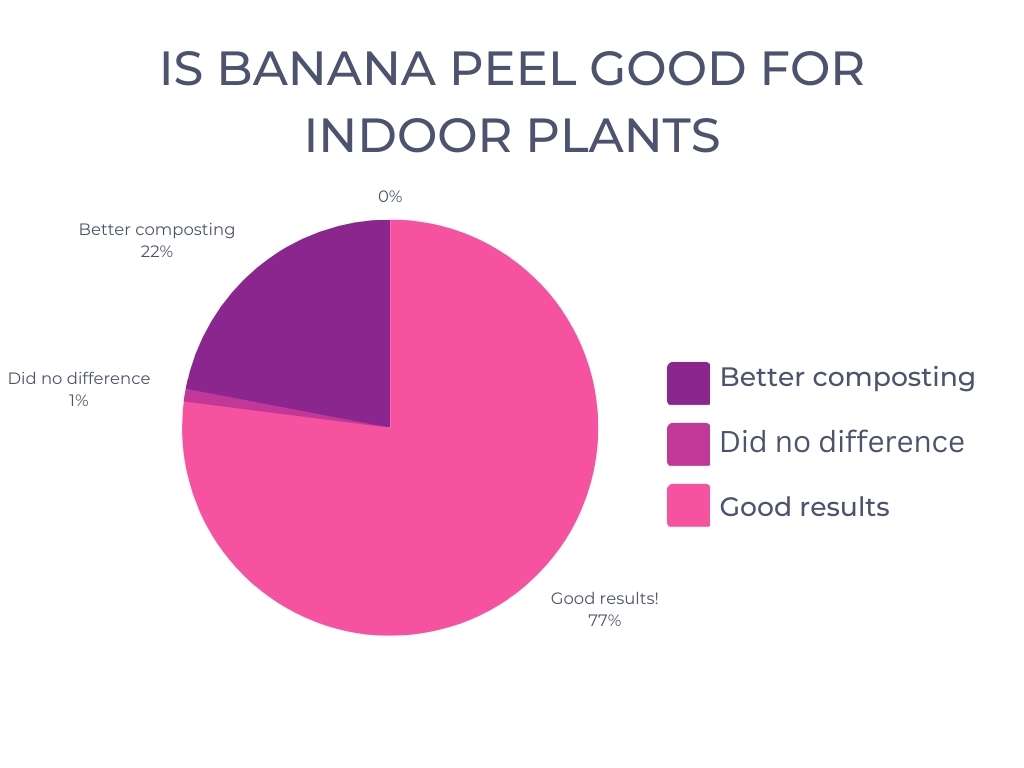
Accordingly, to the data that appears on the above pie chart, 77% of houseplant growers are satisfied with the results they obtained by feeding banana peels to their houseplants.
And 22% disagreed with using them in an indoor garden, cause they found that composting them to use in the garden make more beneficial for them.
Banana peel fertilizer can be good for houseplants cause they encourage flowering, strengthen the plant cells, and develop the root structure to utilize the nutrients, by feeding high Potassium and phosphorous and necessary micronutrients to the plant.
According to the above information, banana peel fertilizer may not that really effective for indoor plants that don’t produce flowers.
But still, using banana peels to increase the Potassium in the soil can be beneficial as they are strengthening the plant cells and produce a better version of your indoor plants.
But always remember the case, that house plants can’t run through the soil to find food on their own. Therefore you have to be careful of supplementing all the nutrient requirements of the plant.
So, if the banana peels do not look like the best option for your houseplant in a particular situation, use the fertilizer that fulfills the essential nutrient requirements at that stage.
For example, you’ve just started growing an elephant ear plant and it’s in the baby stage.
At this stage, you’ve to focus on the stem and leaf growth of the plants. Therefore feeding banana peel fertilizer for this indoor plant won’t be worth it at this stage.
But just imagine that you’ve planted a Jasmine as a houseplant.
When the plant is producing buds and about to produce flowers, use banana peel fertilizer for indoor plants. I can promise you that your plant gonna love it.
Also read: Is seaweed fertilizer good for indoor succulent plants?
Types of banana peel fertilizers for indoor pants
You can turn out a banana peel into fertilizer in a few different ways and in different forms.
But according to the data I’ve collected from experienced gardeners, depending on the type of fertilizer you use, outcomes can have significant differences.
I created this pie chart, based on the replies of indoor gardeners when I asked “how do you use banana peel fertilizer for indoor plants?”
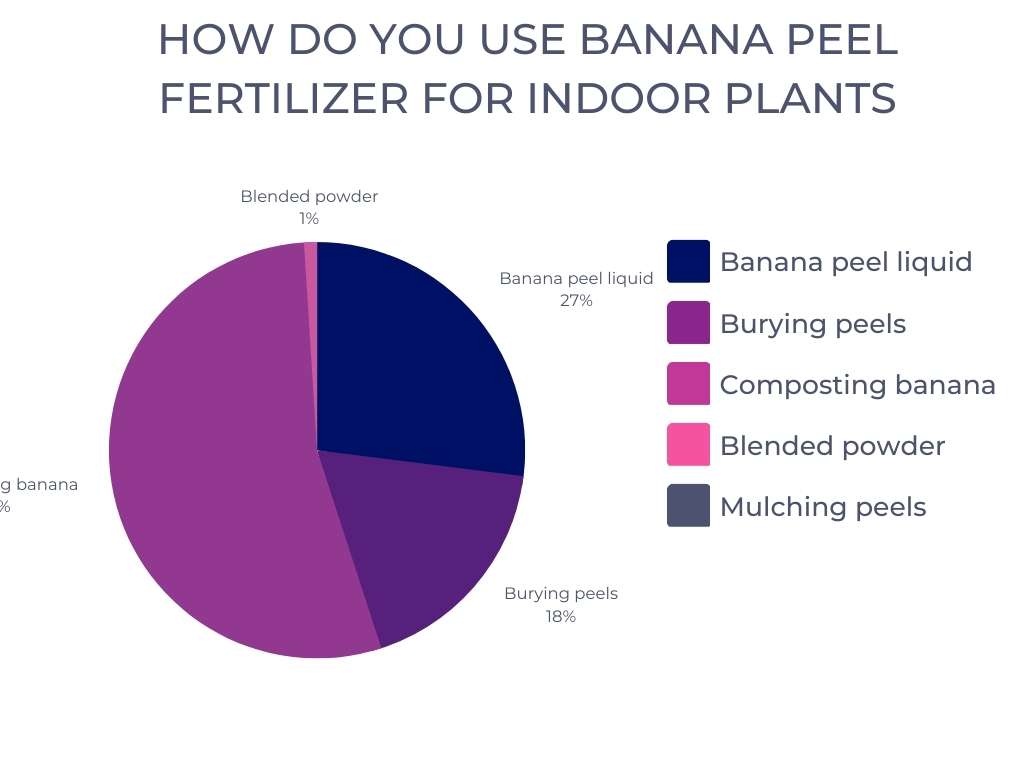
By referring to the above pie chart, you can have a rough idea, that banana peels are used on houseplants in various methods.
But don’t misunderstand that the most popular one is the most successful method.
Because when you’re using banana peel fertilizer for indoor plants there are both pros and cons that you are able to obtain based on the form and type of the fertilizer.
Therefore, let’s move into finding different banana peel fertilizer types and how do you make banana peel fertilizer for indoor plants.
1. Banana peels liquid
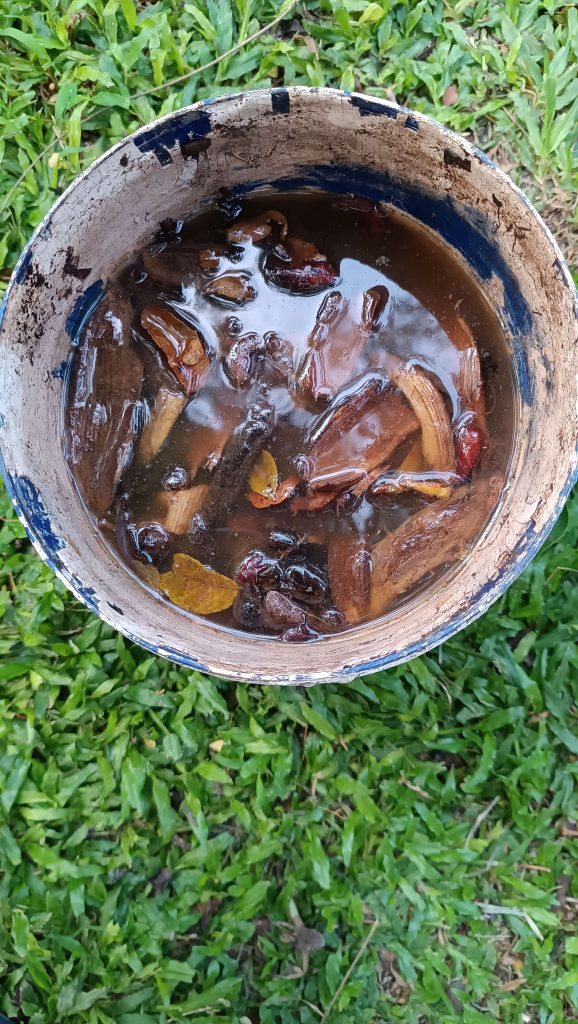
This is the most popular form of using banana peels as a fertilizer.
And this is the laziest and the easiest method of preparing fertilizer from banana peels.
This is how most people prepare this liquid fertilizer.
- Collect some banana peels you left out for your smoothie.
- Chop it off to have a larger surface area for a quicker nutrient breakdown in the fertilizer.
- Put all the peels into a bucket and top it off with water.
- Lid the top and left it for 1-3 days.
After you complete this process, you end up with a whitened watery liquid, and you’ll still be able to see those beautiful yellow-colored banana peels in this liquid.
Also, this will spread out a fruity smell which is well-preferred by fruit flies, as I have seen very often.
I’ve listened to ‘The Indoor Gardener podcast‘ by Greg Draiss a few days ago. And here’s something that he pointed out.
When you compost your gardening waste, once them gets decomposes over time, you won’t find those waste in its original form and color. Indeed they’ll turn out black, wet, and thin layers as they break down their nutrients.
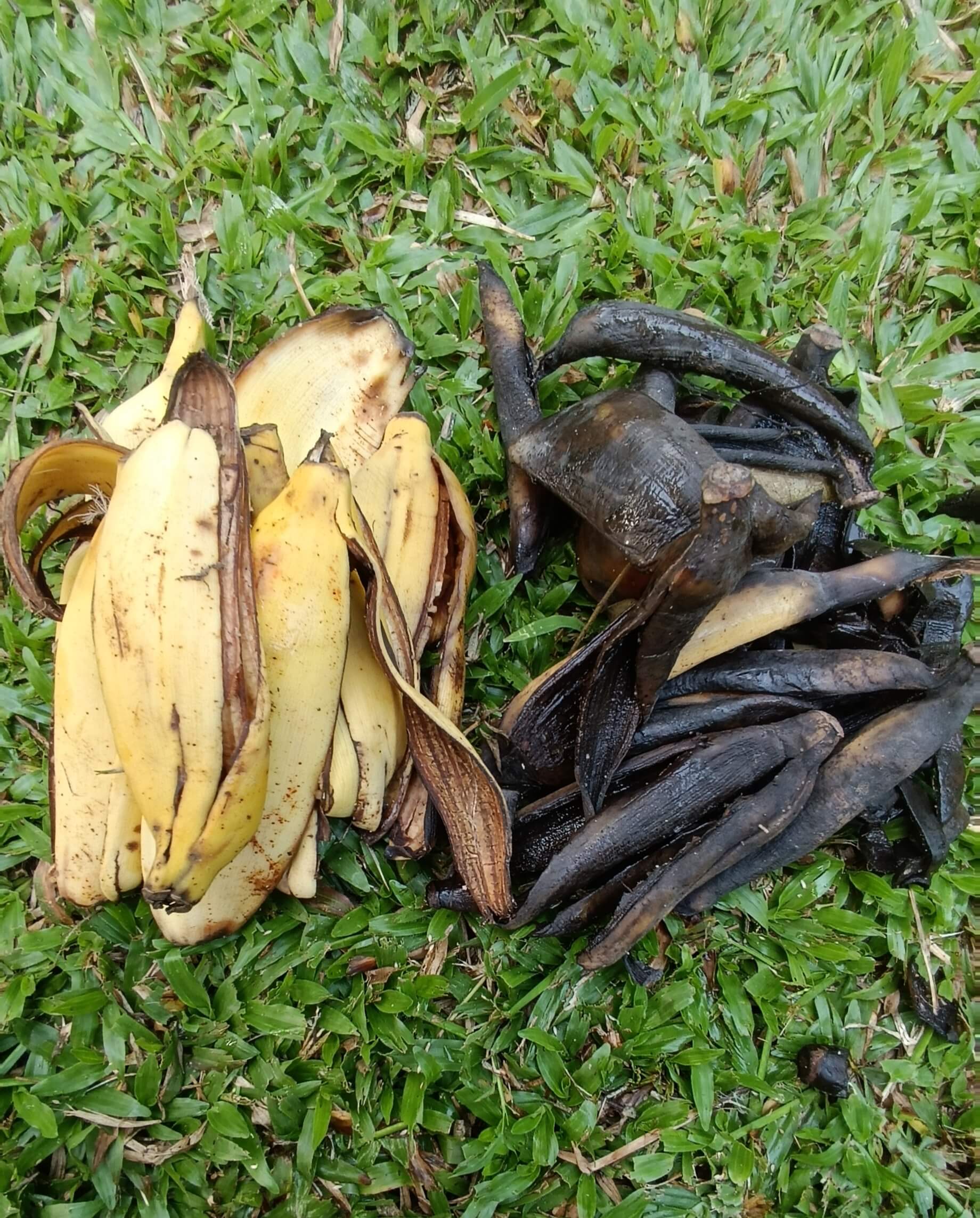
But as most noob gardeners prepare the banana peel liquid fertilizer, they won’t find that kind of a decomposed banana peel. Indeed they even smell as pretty as they like.
So here’s the important thing.
If you want to make an effective banana liquid fertilizer and take the most out of the banana peels I recommend that you should let them stagnate in water for a month or so.
How do you use banana peel water for houseplants?
After you prepared a well-stagnated banana peel fertilizer, dilute as much as 1 cup of fertilizer within 2 cups of water. The perfect results were obtained when feeding banana peel liquid to houseplants every week.
Again, I hardly push you not to dilute too much the liquid. Because banana peels do not contain that kind of massive nutrient content.
Is banana peel water good for indoor plants?
Banana peel water is good for indoor plants as long as the liquid is well-stagnated at least for a month, and diluting it just enough for 1:2 with water to ensure the houseplants utilize the nutritional benefits in a safe manner.
2. Burying banana peels in the soil
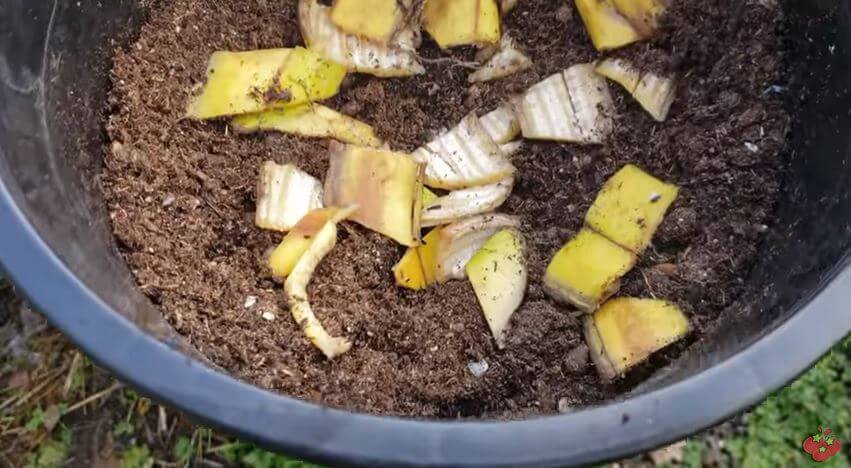
Apart from the banana peel liquid, this may be the following popular method in social media, using banana peels as a fertilizer.
But is it actually worth doing?
Once you bury the banana peels deep in the soil, over time they will decompose slowly but surely, and they will provide fair hands of macronutrients such as Potassium and some other beneficial micronutrients.
On the other hand, banana peels may work as a slow releaser to the soil as they’re releasing their nutrients gently and slowly into the soil.
As we are discussing the effects of banana peel fertilizer on indoor plants, 18% of the indoor gardeners I surveyed had satisfying outcomes by burying banana peels under their houseplants.
But there is a little drawback!
You can only use this method of fertilizing banana peels when your houseplants are planted deep enough. Because if you don’t bury the peels deep enough, most of the time your houseplants may be badly affected by flies, insects, or from even slugs.
So this banana peel fertilizer for indoor plants is not for tiny pots.
How many banana peels are to bury under the houseplants?
As banana peels don’t burn the roots, burying banana peels as much as possible without disturbing the root structure and air circulating process will ensure that a houseplant is having the most out of the banana peels.
3. Composting banana peels
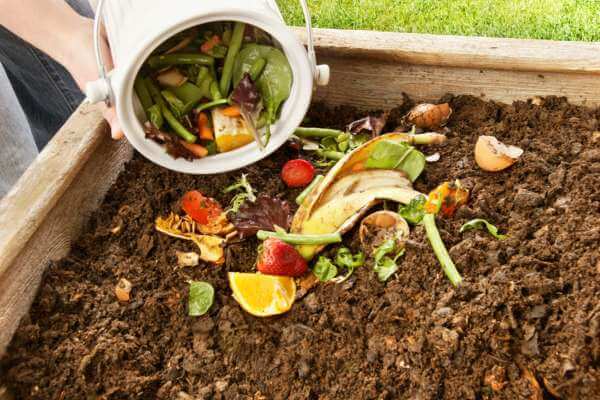
According to my own experience and the research I’ve done with experienced gardeners, composting your banana peels is the most effective, risk-free method to use banana peel fertilizer.
That’s why 54% of gardeners voted on composting banana peels!
You can either start a new compost bin by using only banana peels or just simply throw the banana peels into the normal compost bin.
But if you going with the method of composting only banana peels in a bin, man you need to be patient for at least 2 years!
That’s not possible for anyone.
So the quickest method is to use them in your usual compost bin.
There you already have beneficial microbes, good enough worms, other decomposed organic matter, and good aeration. With those facts, your banana peels can turn out as a decomposed fertilizer within 3-4 weeks.
And if you want to make decomposed banana peel fertilizer for indoor plants way quicker, chop those banana peels into little slices.
According to the Florida University extension, the more surface it covers, the quicker it decomposes. That’s fair to believe. Because it will let more microbes and worms work on the peels.
Remember that you’re well rotating your compost bin and covering it with black to attract more temperature and make a hot compost pile.
Once you’ve done with making compost, I recommend using compost on indoor plants 2-3 times a, year.
Now you’ve done a cool job by amending some more Potassium and phosphorus to the compost mixture 🙂
4. Dried and blended banana peels powder
As far as I am concerned, preparing dry banana peel powder is the quickest method to take out the Potassium based nutrient content on the peels.
As I mentioned earlier, fresh banana peels contain more water than nutrients. And the remaining nutrients also being included in that water.
This research shows that almost every banana variety varies the water content of the fruit by around 85%, which is a large amount of water.
Therefore, if you can dry out that water content, you will end up with a pure Potassium based nutrient source which is 0.6-0.4-11.5 in NPK.
Confirming that, this research about “supplementing banana powder” shows, powdered banana peel’s moisture is low as 6.8% to 7.0% on average.
And the other thing is you can use this banana peel fertilizer for indoor plants as a top dressing fertilizer or a potting soil amendment which can be helpful to the entire plant cell structure.
There are several reasons why you should use dried banana peels over fresh ones.
- Dried ones provide more nutrients than fresh peels.
- Break down nutrients quickly.
- Do not attract pests such as fruit flies.
- No fungal diseases.
How to make banana peel powder to fertilize your indoor plants?
It’s really easy with the below steps.
- Collect well-ripened banana peels and shred them into tiny slices.
- Lie them well under the sun or dehydrate them in an oven
You have to dry them until you will be able to crunch them easily with your fingers. - Then chop them into small chunks.
- Now put all of them into a coffee blender and blend it for 2 minutes.
Bingo!!
You are ready with a high-potassium banana peel fertilizer for your indoor plants.
5. Mulching banana peels
This is kind of a lazy way to use banana peels as a fertilizer for your indoor or outdoor garden.
Yes. Banana peels can work as mulch on the soil while feeding its nutrients over time. But there is more harm than good in my point of view.
If you mulch fresh and fleshy ripened banana peels, that fruity smell will attract fruit flies most of the time.
On the other hand, you also get at some risk of fungal diseases because of the moisture of banana peels.
But if you still prefer to try mulching banana peels on your indoor plants, still there’s a solution.
That is to dry up the peels before mulching them.
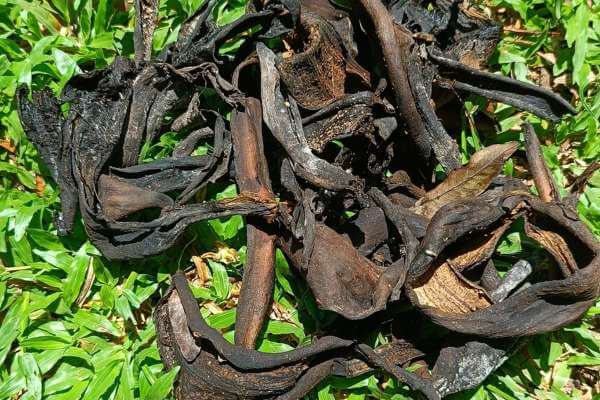
It will reduce the moisture from 85% to all the way down 7% and minimize the chances of fungal diseases. And also you don’t need to be afraid of fruit flies, gnats, or slugs anymore.
Advantages of using banana peel fertilizer for indoor plants
Apart from being a good source of Potassium for your indoor plants, there are some other advantages you can have by using banana peels on houseplants.
1. Aphids repelling ability

Aphids are harmful insects whether you try to grow tomatoes, cucumbers, beans, or any other crops.
Would you believe that banana peels can be turned out as an Aphid insect-repellent?
I got shocked when I heard this first time. But I did experiment with it. And I found what I heard was extremely true.
Because of the strong fruity smell on the banana peel, aphids can’t hang around the plants as they would prefer.
You also can prepare an aphid-repelling sprayer by leaving some banana peels in a water jug for 2-3 days.
2. Reduce the transplanting shock
As it’s clear and obvious banana is a sweet fruit and contains good enough sugar content too.
That’s why players eat bananas during the games to get a quick boost of energy from sugar.
The same happens with your plants, let me say houseplants if you prefer.
When you are moving a plant from one place to another, the entire root structure gets into some sort of trouble because some of the roots are breaking out, and the entire system has to restructure and adapt to a new soil environment.
Using this slurry and sugary banana peel fertilizer for your indoor plants will help them to overcome this transplanting shock.
3. Work as a slow release
As I mentioned earlier, according to science, a banana peel may take up to one to two years to be completely decomposed if you just leave it out in the normal environment.
Therefore, think you’ve deposited some banana peels under your houseplants hoping that they’ll turn into fertilizer by the time.
You guessed that right.
These banana peels can feed over your plant with their ingredients for the next two years!
Disadvantages of using banana peel fertilizers
As well as the advantages, there are some disadvantages of using banana peel fertilizer for indoor plants.
Comparing the nutrient importance, advantages, and disadvantages, you can make your own choice, whether to use banana peels for houseplants or not.
1. Harming the soil structure
If your indoor plants are growing well on the soil you’ve provided, probably that soil has a good soil structure.
A good soil structure always helps to retain moisture, hold nutrition in the soil, and maintain good aeration.
But when you deposit too many banana peels into the soil, the tea composition of that banana soil may reduce the Oxygen content of the soil.
Lack of Oxygen means a lack of aeration of the soil. This will probably lead to a weakened root system of your indoor plants.
Once it diminishes the oxygen, it promotes the anaerobic bacteria in the soil. And this can cause root rot or may also kill the plant.
2. Fungal diseases
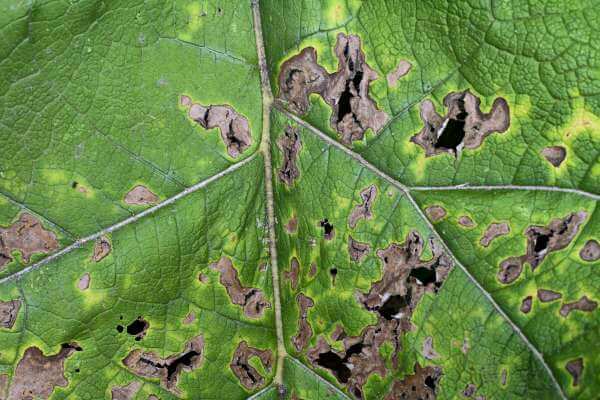
Fungal diseases are more likely to happen when you are using banana peel liquid fertilizer on plants.
By the time when banana peels are soaked in the water, sugar and the Carbohydrates in bananas combine together. And that combination can cause to attract fungal diseases onto your plants once you use them.
3. Attract fruit flies and gnats
Fruit flies and gnats are one of the main drawbacks of using banana peel fertilizer for indoor plants.
If those insects get into a plant, they might also sprawl through your other houseplants too. As if you got hit by this kind of disease, it’s not that very easy to get rid of it.
Most of the time this insect disease occurs when you use fresh banana peels as mulch or banana peel liquid that is not that very stagnated.
But you can still get away with the effect of those fruit flies and gnats by using dried banana peels and dried banana powder as a fertilizer for your outer or indoor plants.
